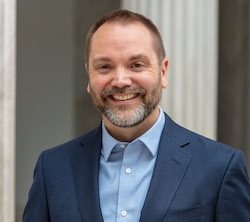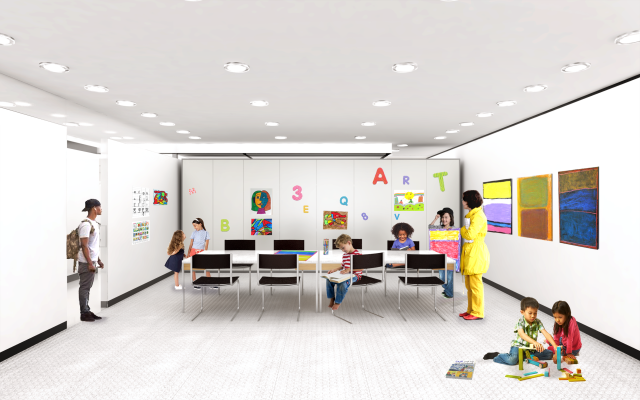Meet Charlie Garling, our new Director of Learning and Creativity, who has big plans for the new museum and its indoor Town Square.

AKG: Did you always want to work in a museum?
Charlie Garling: At first in my mind's eye, I imagined myself with a corduroy jacket with leather patches, and a dowel rod, and glasses that—well they look like these. That was my personification of “knowing things.” And then I realized, after a while, it would be disingenuous for me to teach something without experience doing it, so I switched to studio art, and I focused on printmaking.
AKG: Really?
CG: Specifically, collagraphs. When it comes to printmaking, instead of carving into a surface, you're adding thin layers onto a surface, and then you're printing it. I like that idea of building things rather than taking them away. I did that for a while, and then I started working for the Natural History Museum on Michigan State's campus, teaching art classes to kids, and we ended up painting a little mural. I thought, “Oh, this is for me.”
AKG: You started out in arts education as a teacher for thirteen years. How did that shape you?
CG: I think one of the joys of being a teacher is that you're able to use your creativity to help other people be creative. You do that through your lesson plans, you do that through your words, you do that through the materials that you put out there, you do that through conversations that you're having.
One of my strongest memories of being a teacher actually wasn't about art at all. There was a student in the hallway at the elementary school where I worked, who was upset. He was misbehaving in class because he didn't understand how to tell time on an analog clock. And I had some prep time before class, so I sat down with him, and we talked for like 15–20 minutes, we were drawing things out, the minute hand and the hour, and then something just clicked. He was so excited. He was like, “Oh, I get it!”
And he would have learned it eventually, but I was able to help him discover for himself, and that's really what it's about: helping other people learn for themselves.
AKG: Then you transitioned to the Detroit Institute of Art?
CG: While I was teaching, I worked at the DIA on the weekends, before joining the museum full-time as Director of Studio Programs. I think sometimes art education and art experiences become conflated.
AKG: What is an art experience?
CG: The difference between art education and art experiences are that art education has particular goals to help people learn particular things, whether they're the language of art, or the history of art, or learning about a particular artist, or aesthetics. These are topics that can be learned and understood, and then applied in people's lives. Whereas art experiences are more personally driven. It’s about exploring and expressing oneself comes in. In schools, a lot of the focus is on art education, whereas in museums, we are able to have art experiences that focus on the individual and their own learning, and they're able to determine what is of value to them. We're trying to create an environment where people can construct their identity, and reinforce their identity, and learn more about themselves and about others.
AKG: It’s interesting to hear you speak in terms of identity. What led you to see that art could provide experiences that were self-forming?
CG: In Detroit, we worked with members of human social service agencies: so the Alzheimer's Association, veterans recovering from homelessness, survivors of sexual assault, adults recovering from substance abuse, grandparents who are raising their grandchildren, incarcerated youth, a lot of different underserved populations. And we created creative environments where they could think about their lives and use art to tell their stories.
One of the veterans told us, “The VA saved my life, but this program saved my soul.” When you hear something like that. . . it's just evidence that you’ve created an art experience that can have a real, transformative impact on people's lives.
AKG: Could you give us a picture of what you imagine successful programming to look like?
CG: One of the things that I'd like to do is to bring in artists to our Town Square to put on demonstrations and workshops for the public, so that the public can see the artist’s process and also come up and talk to them—or they can sit back and watch, or they can engage in a related activity. We can create multiple entry points for people to engage at their comfort level, while being able to learn about how somebody else thinks, and learn about the types of processes artist use. So that’s one example of a program.
I’d like for these experiences to become social experiences as well. One of the things that we want to do is create artmaking experiences that happen on a consistent basis, but are fun and accessible and connect with the collection and exhibitions, and cultural holidays, and art techniques, so that everybody can incorporate it into their lives. And then they can come back week, after week, after week, so that it becomes part of their routines. The art is the gravity that pulls everyone here, but it's really the people that that keep it going, and the people are the drivers of it.
AKG: Buildings and space have been a lot on people’s minds here, not just the new gallery spaces, but the new freely accessible spaces, like the indoor Town Square, the Knox Building, and Creative Commons. Beyond making these places accessible, how do you make people feel welcome to be in and use these spaces?
CG: The museum is for everybody. If you want people to feel like they belong, you have to create an environment that they can belong to. You need to give people agency to add to the environment.
We want the public to play a role in programming these spaces. The more we can do that, the more relevant it is to them. And when you work with people to put on their own programs, they're going to talk with people in their community, who can then bring their ideas to the space. The goal is, How do we connect with everybody? And it's a never-ending process.
AKG: Like you said, it’s a never-ending process. How will you know that we’re on the right track?
CG: When who we are is indistinguishable from the from the community.
We'll know when our guests don't feel like guests. We'll know it when this is just a part of their life, and not a separate, special thing. When we start thinking about what's happening in the community, beyond the walls of the institution, as much as we're thinking about what's in the institution, then we become part of the community. When the conversation internally and externally is the same, then we’ve made it.
